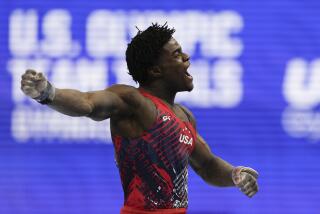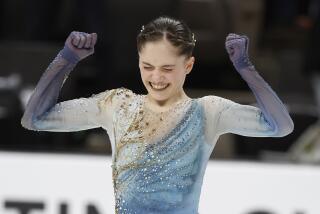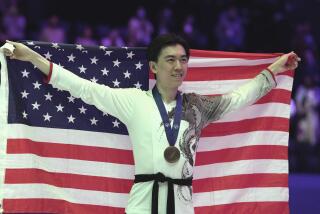Competition Has the Place Jumping
- Share via
SASKATOON, Canada — Figure skating’s quad squad came out Thursday night at Skate Canada and set a cleanly landed quadruple jump as the minimum requirement for standing atop the medal stand at the Salt Lake City Olympics. Veterans Elvis Stojko and Todd Eldredge, unable to perform a quad in their short programs at this Grand Prix event, have cause to wonder if the Olympic parade has passed them by.
Three-time world champion Alexei Yagudin launched a dynamic, crowd-pleasing program with a quadruple toe loop-triple toe loop combination jump, earning unanimous 5.8s (out of 6.0) for his required elements and 5.9s for his presentation. That put the 21-year-old Russian in first place after the first phase of the men’s competition, which will conclude Saturday.
Emanuel Sandhu of Canada, two weeks short of his 21st birthday, breezed past compatriot Stojko with a forceful routine that boasted a quad-triple combo and was ranked second by all seven judges. Stojko, a two-time Olympic silver medalist who is embarking on his last competitive season at 29, touched his hand down on his attempted quad and was ranked third.
Todd Eldredge of the U.S., who landed his only quad in competition a year ago at 29, put his hand down on his quad and took a few steps before taking off for the second part of his combination jump--which he reduced from a triple toe loop to a double. He also had a shaky landing on his triple lutz and was punished by the judges, who gave him two 4.8s and two 4.9s among his marks for required elements. Eldredge, fourth at the 1998 Nagano Games and 10th at Albertville in 1992, was fourth only on the strength of solid presentation scores.
“I was a little surprised,” Eldredge said of his technical marks. “I didn’t think any of my spins were short [of rotations]. The only thing I did was a couple of turns between the first and second part of the combo.... It doesn’t matter that I didn’t get the quad. The most important time to do it is in February.”
Yagudin’s “Winter” program included playful movements in which he scooped up ice shavings and tossed them in the air to float down like snowflakes. His showmanship, power, fast footwork and clean jumps brought him a warm ovation from the crowd of 6,996 at Saskatchewan Place.
‘I was really, really upset at my skating this summer, so I tried to change my skating and my life,” said Yagudin, whose championship reign was ended in March by Russian rival Evgeni Plushenko. “I was working twice, three, four times what I usually do and I was thinking too much about the Olympics. I started trying to lose weight, and it became like a sickness for me.”
Dropping 18 pounds left him too weak to skate well at the Goodwill Games in September. Although he finished third, he called his outing “the worst skating of my life.” He regained about five pounds, to 158, and consulted a psychologist, who told him to permit himself diversions such as tennis and bowling.
“I was so stupid when I thought of the Olympics as something untouchable,” he said. “It’s another event.”
Stojko, hobbled by injuries and unable to cleanly land a quad since the 2000 Canadian championships, skated to the “Kodo” short program he used in 1998 and pronounced himself pleased. “It’s a building block,” he said. “I feel great. My jumps are high. The rotation is there. I just want to push forward toward Salt Lake.”
World pairs champions Jamie Sale and David Pelletier of Canada performed a more polished version of the “Jalousie” short program that helped them win Skate America last week, putting them atop the pairs field. Tatiana Totmianina and Maxim Marinin of Russia were second, with Qing Ping and Jian Tong of China third.
Shae-Lynn Bourne and Victor Kraatz of Canada, who won the Skate America dance title, took the first step toward winning here by being ranked first in the compulsory dance. Galit Chait and Sergei Sakhnovski of Israel were second, followed by Isabelle Delobel and Olivier Schoenfelder of France.
More to Read
Go beyond the scoreboard
Get the latest on L.A.'s teams in the daily Sports Report newsletter.
You may occasionally receive promotional content from the Los Angeles Times.








